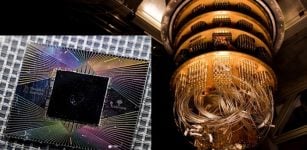KM3NeT Telescope Detected Highest Energy Neutrino In The Mediterranean’s Depths
Eddie Gonzales Jr. – MessageToEagle.com – The international KM3NeT collaboration reports detecting a neutrino of unknown origin with a record energy of about 220 PeV.
Image source
On February 13, 2023, the ARCA detector from the KM3NeT neutrino telescope near Sicily recorded a neutrino with an unprecedented energy of about 220 quadrillion electronvolts (220 PeV). The KM3NeT collaboration reported this significant discovery in Nature. Researchers from the Erlangen Center for Astroparticle Physics at Friedrich-Alexander-Universität Erlangen-Nürnberg led the experiment’s design, construction, and data analysis.
Event “KM3-230213A” details a single muon passing through the ARCA detector in February two years ago, recorded by over one-third of the sensors. The muon’s path and energy suggested it likely originated from a cosmic neutrino. Neutrinos vary by their partner particles: electron, tau, and muon. When neutrinos interact with matter like rock, they can transform into their counterparts, as occurred near the detector two years ago.
Events like radiation bursts from supermassive black holes, supernova explosions, or gamma-ray bursts act as powerful accelerators for cosmic rays. These rays interact with surrounding material or cosmic microwave background radiation, producing neutrinos and high-energy photons. For example, the energy of neutrino KM3-230213A was about 10, 000 times greater than particle beams at the Large Hadron Collider (LHC). Neutrinos have an infinitesimally small mass.
“We have known for approximately one hundred years now that particles are accelerated to extremely high energies in our Universe, but it is still largely unknown where these particles originate from and what causes them to accelerate in this way,” explains Prof. Dr. Claudio Kopper, head of the KM3NeT group at ECAP and holder of the Chair of Experimental Astroparticle Physics at FAU. “Neutrinos allow us to find the sources of these particles. We can also gain an understanding of the processes driving these cosmic particle accelerators, as neutrinos are barely absorbed at all and can therefore deliver very “direct” information from inside these astrophysical accelerators.”
KM3-230213A has been the only event of its kind until now, but the KM3NeT team now hopes to detect further similar occurrences.
Image credit: N. Busser_CNRS
“The neutrino we found using KM3NeT is puzzling,” explains Prof. Kopper. “It has such a high energy, much higher than many of us had expected. As it is the only neutrino with these levels of energy that we have detected to date from this direction, it is currently difficult to come to a conclusion concerning its source. But that is exactly what makes it so interesting, as it is often while doing fundamental research that we make surprising discoveries that lead to new insights.”
Researchers are optimistic because the February 13, 2023, discovery used only one-tenth of the planned detector configuration. The KM3NeT telescope installation continues, with more sensors to be added in coming years, eventually covering over one cubic kilometer.
The KM3NeT telescope
Work began on constructing the KM3NeT telescope in December 2015. FAU astroparticle physicists have taken a leading role in the project from the outset. In the event that has now been recorded, they were mainly responsible for visualizing and providing further data to the scientific community.
“It is great that we were able to make a discovery like this in the opening phase, showing us that we are on the right path with KM3NeT,” says Prof. Uli Katz from the Chair of Astroparticle Physics at ECAP, and one of the founding members of the KM3NeT project.
The telescope uses seawater as a detection medium and a shield against cosmic ray interferences. Its optical sensors detect Cherenkov light, a bluish glow from fast particles created by neutrino interactions in water.
KM3NeT has two components: ARCA and ORCA. ARCA, for Astroparticle Research with Cosmics in the Abyss, studies high-energy neutrinos and their sources. It’s 3450 meters deep, 80 kilometers off Sicily’s coast. ORCA, for Oscillation Research with Cosmics in the Abyss, examines neutrinos’ basic properties. It’s 2450 meters deep, 40 kilometers off Toulon’s coast in France.
The KM3NeT collaboration currently involves more than 360 scientists, engineers, technicians and students from almost 70 institutions in more than 20 countries across the globe.
Written by Eddie Gonzales Jr. – MessageToEagle.com Staff Writer












